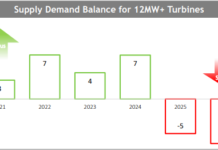John Petersen
In 2009, the world produced some 13.2 billion metric tons of hydrocarbons, or about 4,200 pounds for every man, woman and child on the planet. Burning those hydrocarbons poured roughly 31.3 billion metric tons of CO2 into our atmosphere. The basic premise of alternative energy is that widespread deployments of wind turbines, solar panels and electric vehicles will slash hydrocarbon consumption, reduce CO2 emissions and give us a cleaner, greener and healthier planet. That premise, however, is fatally flawed because our planet cannot produce enough non-ferrous industrial metals to make a meaningful difference and the prices of those metals are even more volatile than the prices of the hydrocarbons that alternative energy hopes to supplant.
The ugly but undeniable reality is that aggregate global production of non-ferrous industrial metals including aluminum, chromium, copper, zinc, manganese, nickel, lead and a host of lesser metals is about 35 pounds for every man, woman and child on the planet. All of those metals are already being used to provide the basic necessities and minor luxuries of modern life. There are no significant unused supplies of industrial metals that can be used for large-scale energy substitution. Even if there were, the following graph that compares the Dow Jones UBS Industrial Metals Index (^DJUBSIN) with the Amex Oil Index (^XOI) shows that industrial metal prices are more volatile and climbing faster than hydrocarbon prices, which means that most alternative energy schemes are like jumping out of the frying pan and into the fire.

For all their alleged virtues and perceived benefits, most alternative energy technologies are prodigious consumers of industrial metals. The suggestion that humanity can find enough slop in 35 pounds of per capita industrial metals production to make a meaningful dent in 4,200 pounds of per capita hydrocarbon production is absurd beyond reckoning. It just can’t happen at a relevant scale.
I’m a relentless critic of vehicle electrification schemes like Tesla Motors (TSLA) because they’re the most egregious offenders and doomed to fail when EV hype goes careening off the industrial metals cliff at 120 mph. Let’s get real here. Tesla carries a market capitalization of $2.8 billion and has a net worth of less than $400 million, so its stock price is 86% air – a bubble in search of a pin. Tesla plans to become a global leader in the development of new electric drive technologies that will use immense amounts of industrial metals to conserve irrelevant amounts of hydrocarbons. Even if Tesla achieves its lofty technological goals it must fail as a business. Investors who chase the EV dream without considering the natural resource realities are doomed to suffer immense losses. Tesla can’t possibly succeed. Its fair market value is zero. The stock is a perfect short.
I won’t even get into the sophistry of wind turbines and solar panels.
Next on my list of investment catastrophes in the making are the lithium-ion battery developers like A123 Systems (AONE), Ener1 (HEV), Valence Technologies (VLNC) and Altair Nanotechnologies (ALTI) that plan to use prodigious quantities of industrial metals as fuel tank substitutes, or worse yet for grid-connected systems that will smooth the power output from inherently variable wind and solar power facilities that also use prodigious quantities of industrial metals as hydrocarbon substitutes. Talk about compounding the foolishness.
I can only identify one emerging battery technology that has a significant potential to reduce hydrocarbon consumption and industrial metal consumption at the same time while offering better performance. That technology is the PbC® Battery from Axion Power International (AXPW.OB), a third generation lead-acid-carbon battery that uses 30% less industrial metals to deliver all of the performance and five to ten times the cycle life. There may be other examples, but I’ll have to rely on my readers to identify them.
Humanity cannot reduce its consumption of hydrocarbons by increasing its consumption of industrial metals. The only way to reduce hydrocarbon consumption is to use less and waste less. There are a world of sensible and economic fuel efficiency technologies that can help us achieve the frequently conflicting long-term goals of reduced hydrocarbon consumption and increased industrial metals sustainability. They include but are not limited to:
- Better buiding design and insulation;
- Smarter power management systems;
- Telecommuting;
- Denser cities with shorter commutes;
- Smart transportation management to reduce congestion;
- Buses and carpooling;
- Bicycles and ebikes;
- Shifting freight to rail from trucks;
- Smaller vehicles that use lightweight composites to replace industrial metals;
- Deploying solar and wind with battery backup for remote power and in developing countries;
- Shipping efficiency technologies, such as better hull coatings, slow steaming, etc.; and
- Recycling, recycling and recycling
My colleague Tom Konrad wrote a 28 part series on “The Best Peak Oil Investments.” While I’m skeptical about the future of biofuels after suffering major losses in the biodiesel business, Tom’s work provides an exhaustive overview of the energy efficiency space and a wide variety of investment ideas that have the potential to make a real difference. Since we can’t simply take a couple of giant leaps into the future, we’ll just have to get out of our current mess the same way we got into it – one step at a time.
We live in a cruel world. There is no fairy godmother that can miraculously accommodate the substitution of scarce industrial metals for hydrocarbons that are a hundred times more plentiful. We can and we must do better, but we can’t solve humanity’s problems until we accept the harsh realities of global resource constraints without the filters of political ideology and wishful thinking.
Disclosure: Author is a former director of Axion Power International (AXPW.OB) and owns a substantial long position in its common stock.









Great article, John. However, the world seems to be ignoring your argument and pushing full speed ahead with solar, wind, and EVs as the ultimate replacement for cheap peak oil and CO2 pollution. You make so much sense, yet, with so much weight and money on the other side, I have to wonder whether there is a flaw in your analysis. What is the best counter-argument to yours?
The world isn’t ignoring the argument, it’s never considered the argument. We all grew up in a charmed time where the word “shortage” simply meant that we could expect higher prices in the future. The idea that there isn’t more than enough of everything to go around is foreign to us. As a result we make decisions based on a “presumption of plenty” that’s inherently flawed. There may have been plenty when the BRICs were bastions of poverty, deprivation and ignorance. Now that the have-nots understand that there is more to life than mud huts the world is a very different and very scary place.
Pathetic plug for Axion by one of its biggest shareholders. You should be ashamed to manipulate information to suit your economic ambitions.
Attacking the messenger because you can’t argue with, or for that matter respond to, a set of facts you don’t like does not change cruel reality.
Yes I’m a big stockholder of Axion.
Yes Axion has the only technology I know of that saves both hydrocarbon and industrial metal resources.
That would mean I’ve chosen well wouldn’t it?
DENIAL is not a river in Egypt.
Did the Club of Rome get it right then, just a bit early, the main difference being all those billions finally coming out of poverty and seeing and wanting what the developed world has?
I remember hearing about the Club of Rome in my youth but never really understood their purported message. I lay the problem at the foot of the information and communications technology revolution that gave half the world’s poor access to proof that there is something better and gave them a clear incentive to work for a place at the table. That’s why I keep reminding readers that our greatest challenge as a species is finding RELEVANT SCALE SOLUTIONS to persistent shortages of water, food, energy and every commodity you can imagine.
You are not the messenger. You are the propagandist.
Here’s why your article sucks:
You compare oil and metals by weight. Why? There is no basis for this. Very different amounts do very different things – how much vanadium does it take to make a battery? Not 4,200 pounds. I honestly don’t even know why you presented these numbers side by side.
Oil is used for energy production. Metals are used for storage – at least in the way you paint them for lithium battery companies.
You compare metals to oil according to market price. However, the price of a barrel of oil does not take into account the cost of the environmental and social impacts of the use of oil, which are still external to markets in most cases. This is, in fact the reason for such major policy shifts toward alternative energies.
Potatoes are abundant and cheaper than a well-balanced diet. John Petersen, do you only eat potatoes? No? Why? Because you would pay far more in terms of health care bills, and decreased quality of life.
Good luck with Axion – it is a fine company… if you like potatoes.
You’ve missed the point completely. The world does not produce enough industrial metals to permit the fabrication of enough batteries to make a difference in total hydrocarbon consumption.
The weights prove it.
Global Vanadium production was about 1/4 ounce per person in 2011. That is nowhere near enough to make a dent in 4,200 pounds of hydrocarbon production and it never will be. Focusing on the needs of the one instead of the needs of the many will always lead to an irrational conclusion.
I’m a scientist working on new types of solar cells at a national lab, and have to disagree with the myopic outlook of this article. There are a few cases where some metals will be a limiting factor, but I can tell you that we are developing new materials to replace nearly anything he can mention. I’ve discussed with MANY other scientist working in all parts of the sustainable energy field: solar, wind, batteries, fuel cells, magnets (for electric motors). For the most part there are clear solutions to limitations of particular elements.
Having said that, I agree with the author that people are going to have to use less and waste less. That’s just the way it’s got to be.
I’m a lawyer who’s been involved in corporate finance for R&D stage companies for over 30 years now. The things I’ve noted are (1) most R&D projects fail long before they reach the product stage, (2) until R&D is successfully completed we have to do with the same old same old.
Reality is there are not enough metals to move forward in a meaningful way with current technology. When that situation changes I’ll be the first to stand and cheer. The fact that “what might be” could overcome the resource problem does not make “what is” a sensible investment.
When it comes to strategic metals for scaling up the renewable energy industry, surely the question shouldn’t be “how much are we producing today?” but “how much can we produce tomorrow, and at what price, financial and social?” I don’t see any attempt to answer the latter question, so I find the argument unconvincing. I also second Dannel Malloy’s criticism about apples and oranges. Fossil fuels are nonrenewable bulk consumables. Strategic metals are consumed once during manufacturing, typically in small quantities, and can later by recycled to varying degrees.
I submitted this comment yesterday via the Facebook option. It was online by last night, but today it’s gone. To repeat:
When it comes to strategic metals for scaling up the renewable energy industry, surely the question shouldn’t be “how much are we producing today?” but “how much can we produce tomorrow, and at what price, financial and social?” I don’t see any attempt to answer the latter question, so I find the argument unconvincing. I also second Dannel Malloy’s criticism about apples and oranges. Fossil fuels are nonrenewable bulk consumables. Strategic metals are consumed once during manufacturing, typically in small quantities, and can later by recycled to varying degrees.
Baumel:
What happened is that you probably did not hit “refresh” when viewing the page. That’s why you should see your comment twice, now.
Tom, no I refreshed the page at least once. Sometime after I posted my second attempt, when I came back to see if it had been accepted the first one was there again, mocking my earlier complaint! The first one was posted directly via Facebook. Perhaps the implementation of that is a little flaky. To post the second one, I registered with TypePad (via my Facebook account), which gave me the user name you see in the 2nd attempt but not the first.
Our ability to produce industrial metals, like our ability to produce oil, has been declining for decades and we’re already deep into deposits that were considered uneconomic when I was young. Moreover the UN recently studied global recycling rates of some 60 strategic metals and found that recycling rates were over fifty percent for fewer than 20 of the metals and under 1% for 34. My statements about industrial metals are every bit as factual as your statements about oil and it really doesn’t matter whether you choose to accept reality or not. The reality won’t change.
Mark Jacobson (Stanford) and Mark Delucchi (UC Davis) have published a detailed scenario for powering the world with renewables by 2050 in Scientific American and, in greater detail, in a journal called Energy Policy. In their first of two papers on the subject in EP, they address the subject of required materials availability, and conclude it probably won’t be a problem. See http://www.stanford.edu/group/efmh/jacobson/Articles/I/JDEnPolicyPt1.pdf, section 5, “Material Resources,” pp 1161-64.
I love discussions like those that start with the entire global production of a commodity, increase it by an order of magnitude or two and then assume that all competing uses are irrelevant.
The world does not work that way and people are not going to stop consuming the things that already use 100% of global supply to make room for alternative energy.
The argument is sophistry.
The way the world works is that resource industries try very hard to limit their commodity production so that supply doesn’t greatly exceed demand, so it’s to be expected that we’re currently using more or less 100% of strategic metal supply. The question is whether that supply can rise to the occasion if demand soars over the coming decades. Jacobson and Delucchi provide a detailed “metal by metal” argument in a peer-reviewed journal that specializes in energy issues that it probably can. This woud be the rule, not the exception, because history is full of examples of exponential growth in the production or extraction of a commodity in response to soaring demand, from those 4200 pounds per capita of fossil fuels to the lead in your favourite batteries. I find J and D’s fully-referenced analysis far more persuasive than mostly rhetorical naysaying.
My thirty years of experience in extractive industries and my colleagues at Technology Metals Research who are true experts in the industrial metals space tell me that the academics are wild eyed dreamers who don’t have a clue about what it takes to get industrial metals out of the ground and into the market.
Their “peer reviewed” references to mineral deposits in Afghanistan and other countries where hundreds of billions in infrastructure spending will be needed before any of the known resources have any value are proof of that premise. The peers don’t understand the issues either.
HL Menken observed that “Explanations exist; they have existed for all time; there is always a well-known solution to every human problem — neat, plausible, and wrong.”
You can believe whatever theories make it easier for you to sleep at night. But I can assure that the miner’s life on and under the ground is nowhere near as simple as it seems from Stanford and Davis.
What is it about the scaling up of the extraction and refining of lithium, neodymium et al. that you and your colleagues find so daunting compared to the same (or greater) historic achievements with respect to such commodities as coal, oil, gas and iron?
Infrastructure – Hundreds of Billions of Infrastructure that simply does not exist in the remote countries where they mythic resources are located.
Coal, oil, gas and oil were all discovered where people already lived and infrastructure already existed. Building new infrastructure where people don’t live is an entirely different story. In most cases, the cost of building enough infrastructure to extract the metals will be more than the metals are worth.
It’s all economics and there is no natural resource fairy to make the insurmountable economic burdens manageable. There’s a reason that these resources are known but undeveloped. They’ve never been worth the pain and they won’t be worth the pain in the foreseeable future.
Barring political or military opposition (and often despite it), capital always flows where money can be made by satisfying a vital/strategic demand. Look at the tremendous growth of infrastructure in China alone these past few decades, transforming a sleeping rural giant into the world’s manufacturing hub. How much infrastructure was there in the gulf states before American oil no longer could meet demand? Capital stampeded there to build infrastructure.
“There’s a reason that these resources are known but undeveloped. They’ve never been worth the pain and they won’t be worth the pain in the foreseeable future.” It sounds like your argument isn’t about what’s possible; it’s about what’s desirable from your point of view, which appears to be that serious global deployment of renewable energy and technology, like EVs, that flourishes in a renewable energy environment is undesirable.
I don’t make value judgments about what is or is not desirable because I only care about sensible investing. Absent earth shattering change most alternative energy schemes will never be sensible because the materials required to implement them will not be available.
But increasingly expensive (peak oil) and deleterious (coal, fracked natural gas) fossil fuels will continue to be sensible? The impact of relying on these to power the world is indeed earth-shattering. Nuclear is increasingly expensive (unlike, most notably, solar) and comes with risks that people, increasingly, don’t want to take.
As I said, you’re free to believe any mythology that helps you sleep better at night. I’m done with this increasingly silly argument with an obvious ideologue who does not understand, or for that matter want to understand, what is and what is not possible in the real world.
Oil, gas and coal are 100 times more plentiful than industrial metals. You can try till hell freezes over and you’ll never replace one with the other. It simply can’t happen because the natural resources do not exist.,
There is one and only one sensible alternative energy investment. That investment is conservation – using less, wasting less and insuring that every resource is allocated to its highest and best purpose.
I certainly agree on conservation (and energy efficiency). Your other arguments, which amont to very little more than repetitious naysaying and argument from your own authority, are failing to add any value to your thesis. E.g. If fossil fuels are 100 times more plentiful than industrial metals, that’s hardly an endorsement. The one (fossil fuels) is unrenewably used up every day in mass quantities; the other is used to create durable products and can be recovered and recycled to a very large extent at the end of those products’ life cycle.
Anyway, we’ve clearly passed the point of diminishing returns or constructive discussion. You’ve done nothing to disabuse me of my supposed mythology, not because I refuse to learn or understand but because you appear unwilling or unable to defend your own mythology and to debunk the alleged mythology of scientists like Jacobson and Delucchi with facts and reason.